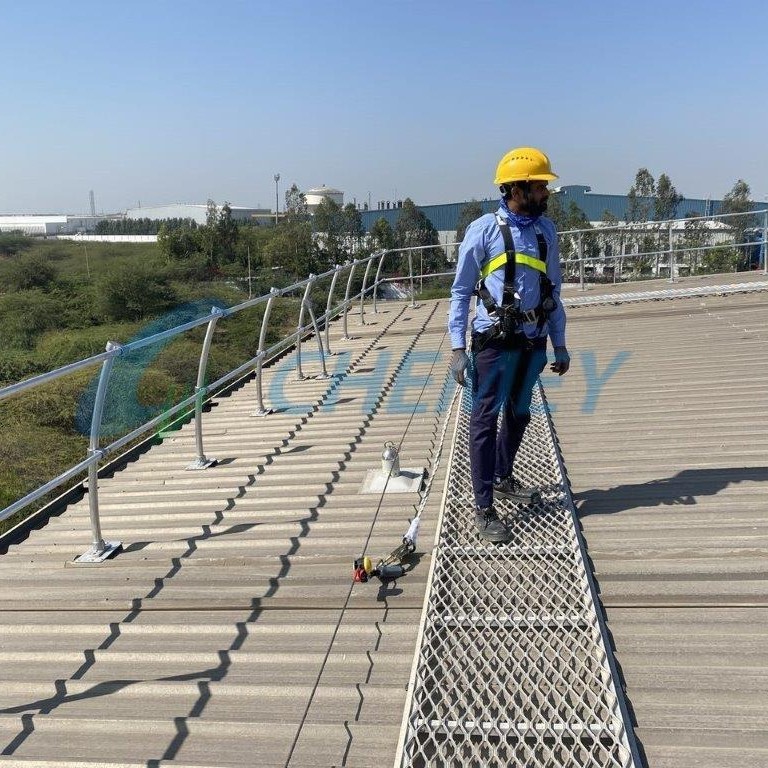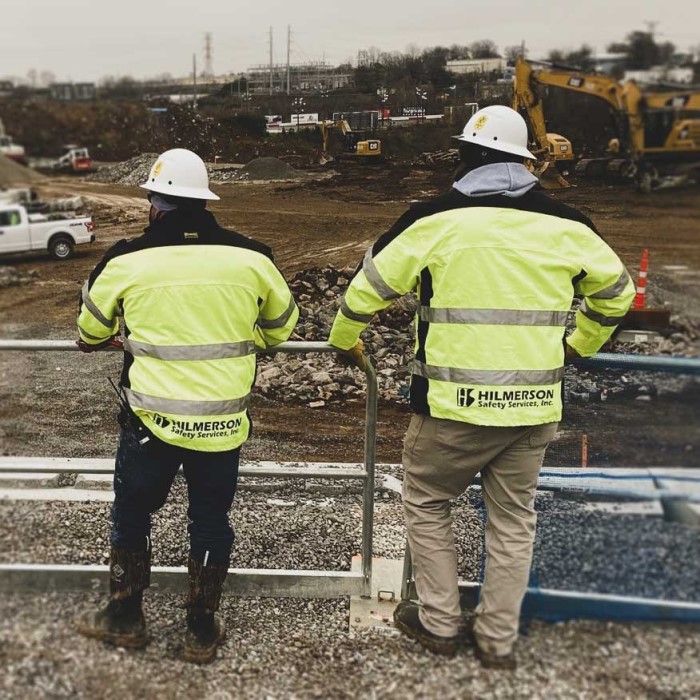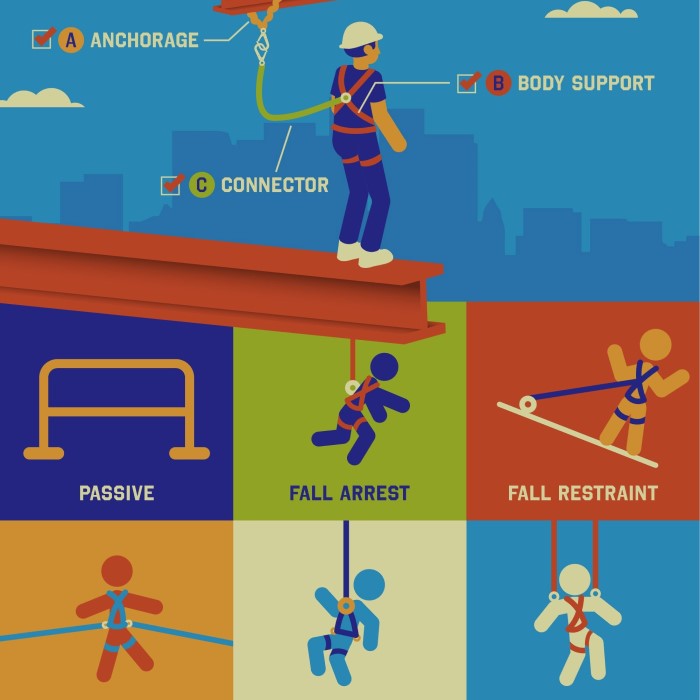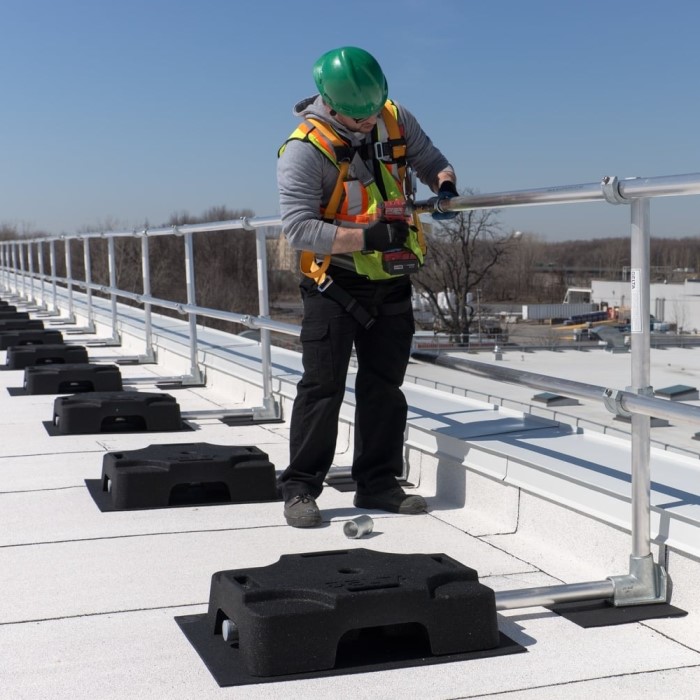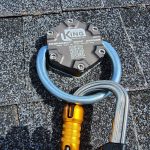Introduction to Passive Fall Protection
Passive fall protection system is essential for safeguarding workers in elevated areas. They remain in place without requiring user involvement, providing continuous protection. By focusing on preventing falls altogether, these systems ensure safety and compliance in various industries.

What is Passive Fall Protection?
Passive fall protection refers to safety measures that support fall prevention without user action. These systems include guardrails, safety nets, parapet walls, and similar barriers. Unlike active systems, such as harnesses, passive fall protection works constantly without requiring interaction. This makes them reliable and easier to use, ensuring consistent safety across work environments.
Importance of Fall Protection Systems
Fall protection systems are vital for minimizing workplace injuries and fatalities. Falls are one of the leading causes of accidents, especially in construction, manufacturing, and warehousing. By implementing a passive fall protection system, businesses can protect workers, comply with regulations, and avoid costly fines. These systems not only save lives but also create safer workplaces for all employees.
Types
Passive fall protection systems offer reliable safety by preventing falls at elevated locations. These systems do not require active participation, ensuring continuous and easy-to-use protection. Here are the primary types of passive fall protection systems:
Guardrails and Handrails
Guardrails and handrails are the most common type of passive fall protection. They create a physical barrier to prevent falls. Installed at the edges of elevated surfaces, they provide constant safety. Handrails also assist in maintaining balance when moving along stairs or inclined paths. They are cost-effective and easy to install, making them a popular choice in industries.
Safety Net Systems
Safety nets catch workers or objects that may fall. They are especially useful in construction sites where guardrails can’t be installed. These systems act as a backup, reducing the risk of serious injuries. Safety nets must be installed and maintained properly to ensure effectiveness. They are durable and can cover wide areas, offering comprehensive protection.
Parapet Walls
Parapet walls are low walls typically used at the edges of roofs or elevated structures. They offer both fall protection and aesthetic value. These walls are permanent solutions that blend with building architecture. They are ideal for locations where guardrails may not be practical. Parapet walls are especially effective for rooftop safety.
Fall Arrest Mats and Cushions
Fall arrest mats and cushions reduce the impact of falls. They are placed on the ground below work areas. These systems are portable, making them suitable for various work environments. They are commonly used in maintenance, construction, and entertainment industries. Fall arrest mats protect workers while minimizing potential fall injuries.
By selecting the appropriate passive fall protection system, businesses can provide better safety at work.
Features and Benefits of Passive Fall Protection
Passive fall protection systems are essential in ensuring workplace safety. These systems offer unique advantages that make them a reliable choice.
Key Advantages
- Ease of Use: Passive fall protection systems require no user interaction. Once installed, they continuously provide safety.
- Consistent Protection: Unlike active systems, they work around the clock. Workers remain safe without needing to wear or adjust equipment.
- Cost-Effective: These systems have low maintenance needs. Their one-time installation cuts ongoing expenses.
- Compliance with Regulations: Using these systems helps businesses meet safety guidelines. They reduce the risk of penalties and fines.
- Enhanced Worker Confidence: Workers feel safer in a well-protected environment. This can improve productivity and morale.
How They Differ from Active Systems
- No User Training Needed: Passive systems function without the need for special training. Active systems require knowledge of proper usage.
- Stationary Components: Passive systems remain fixed in place. Active systems involve wearable gear like harnesses and lanyards.
- Minimal Maintenance: Passive fall protection like guardrails requires fewer inspections. Active systems demand regular checks and replacements.
- Broader Coverage: Passive systems protect everyone in the area. Active systems work only for individuals using them.
By understanding these differences, businesses can choose the best solution for their safety needs. Passive fall protection systems provide dependable and hassle-free safety options in various environments.
Industries That Utilize Passive Fall Protection
Passive fall protection systems are crucial in many industries where workers face fall risks. These systems ensure safety, reduce accidents, and promote efficiency. Here’s how different industries use passive fall protection systems effectively.
Construction Sites
Construction sites are prone to fall-related accidents due to elevated work areas like rooftops and scaffolds. Passive fall protection systems such as guardrails and safety nets help secure workers at height. Guardrails prevent falls from edges, while safety nets catch workers or debris during accidental falls. These systems are essential for maintaining safety on construction sites.
Manufacturing Facilities
Manufacturing facilities often require workers to navigate elevated platforms, machinery, or assembly lines. Passive fall protection systems like parapet walls and handrails are common here. Parapet walls protect workers on rooftops, while handrails provide support in areas with stairs or walkways. These systems keep employees safe while maintaining productivity.
Warehouses and Storage Areas
Warehouses and storage areas see frequent movement near high shelves and elevated workspaces. Passive fall protection systems, such as fall arrest mats and guardrails, help safeguard workers performing tasks at height. Fall arrest mats reduce impact injuries, and guardrails stop accidental falls from platforms. These systems are vital in warehousing to minimize risks.
Passive fall protection systems adapt to varied industries to ensure consistent worker safety. Businesses must choose and implement the right protection for their specific needs to create secure work environments.
Passive Fall Protection Regulations and Standards
Ensuring compliance with passive fall protection regulations is crucial for workplace safety. Standards are set by regulatory bodies to guide the use and implementation of these systems. Two major organizations provide benchmarks for passive fall protection: OSHA and ANSI.
OSHA Guidelines
The Occupational Safety and Health Administration (OSHA) establishes fall protection requirements. These guidelines focus on preventing workplace injuries through proper safety measures. Employers must comply with OSHA standards to avoid penalties and ensure worker safety.
- Height Requirements: OSHA mandates fall protection for work at elevations of six feet or more.
- Guardrail Standards: Guardrails must be at least 42 inches high with midrails at about 21 inches.
- Safety Nets: Nets must be strong enough to catch a worker without breaking.
- Floor Opening Covers: Openings must be covered or guarded to prevent falls.
- Parapet Walls: Walls must meet specific height and structural requirements for rooftop use.
Employers are responsible for identifying hazards. They must install and maintain passive fall protection systems. Regular inspections are necessary to ensure compliance.
ANSI Standards
The American National Standards Institute (ANSI) provides detailed guidelines. These standards complement OSHA regulations and offer technical requirements for passive fall protection systems. ANSI standards focus on system design, installation, testing, and maintenance.
- System Strength: Passive systems must withstand required weight limits and impact forces.
- Testing Protocols: ANSI defines testing methods to ensure system reliability.
- Durability Measures: Materials used must resist wear, corrosion, and environmental damage.
- Specific System Guidelines: Guardrails, safety nets, and parapet walls must meet ANSI specifications.
- Documentation and Certification: Systems must have proper records and certifications to confirm compliance.
Following ANSI standards enhances overall safety and aligns with industry best practices. It aids employers in implementing robust solutions.
By adhering to OSHA and ANSI regulations, businesses can create safer environments. These standards are essential for preventing falls and protecting workers.
Installation and Maintenance of Passive Fall Protection Systems
Proper installation and maintenance are vital for passive fall protection system effectiveness. Ensuring these aspects can save lives and prevent workplace injuries.
Proper Installation Techniques
- Site Analysis: Inspect the worksite carefully before installing the passive fall protection system. Identify hazard areas and assess fall risks, such as elevated edges or openings.
- System Design: Design the system to suit the specific needs of the worksite. Use the correct type of passive fall protection system based on the environment. For example, guardrails are ideal for platforms, while safety nets work well for construction sites.
- Follow Manufacturer Instructions: Adhere strictly to manufacturer guidelines during installation. Incorrect setup can compromise the system’s effectiveness.
- Use Quality Materials: Select durable materials that can endure high stress, environmental impact, and wear. For instance, safety nets should be strong enough to catch workers or falling objects.
- Hire Professionals: Employ qualified installers to ensure the system meets safety standards. Their expertise minimizes installation errors and boosts system reliability.
- Secure Fastening: Check that all components, such as rails and brackets, are tightly fixed. This prevents premature failure.
Regular Maintenance and Inspections
- Scheduled Inspections: Set up regular inspections of the passive fall protection system. Inspect every component for damage or wear.
- Cleaning: Clean the system to prevent material erosion or build-up of debris. Focus on preventing rust and ensuring longevity.
- Repair Damages Immediately: Fix damaged components promptly to avoid accidents or further deterioration. Replace parts when necessary.
- Compliance Checks: Ensure the system aligns with OSHA and ANSI guidelines during inspections. This avoids penalties and improves worker safety.
- Record Keeping: Maintain clear records of all inspections and repairs. This ensures accountability and tracks system condition.
- Provide Training: Offer training to staff about the importance of maintenance. Encourage workers to report damages or risks.
Proper installation and consistent maintenance ensure that passive fall protection systems remain reliable and effective. Businesses can create safer environments by focusing on these practices.
Choosing the Right Passive Fall Protection System
Selecting the right passive fall protection system is essential for workplace safety. These systems must suit the environment and meet specific safety demands. Careful evaluation ensures maximum effectiveness and compliance with regulations.
Factors to Consider
- Work Environment: Assess the type of worksite and its hazards. Elevated platforms, rooftops, and open edges may need different systems.
- Compliance Requirements: Ensure the system meets OSHA and ANSI guidelines. This prevents penalties and enhances safety.
- Durability: Choose materials that can resist wear, weather, and stress. Durable systems reduce maintenance costs.
- Ease of Installation: Opt for systems that are simple to install. Professional installation ensures reliability and compliance.
- Cost-Effectiveness: Balance upfront costs with long-term benefits. Low-maintenance systems often save money over time.
- Flexibility: Select systems that can adapt to changing needs. For instance, portable mats or modular guardrails may suit temporary worksites.
- Worker Compatibility: Ensure the system suits employees’ tasks without interrupting workflows. Safe and practical solutions improve productivity.
- Area Coverage: Verify that the system provides complete protection for all risky areas.
Custom Solutions for Specific Needs
- Tailored Designs: Some industries need custom solutions, like parapet walls designed for specific buildings. Custom systems enhance safety and fit seamlessly into unique structures.
- Specialized Materials: Choose materials suitable for the environment, such as corrosion-resistant options for outdoor locations.
- Temporary Worksites: Portable passive fall protection, like fall arrest mats, offers flexibility for dynamic or short-term projects.
- Architectural Integration: Consider systems that blend aesthetically with the site, especially for residential or commercial buildings.
- Expert Consultation: Seek professional advice to design systems tailored to the worksite. Experts help optimize safety and compliance.
By assessing needs and customizing solutions, businesses can ensure the best passive fall protection system. Investing effort in selection safeguards workers and enhances operational efficiency.
Conclusion
Ensuring Safety with Effective Passive Fall Protection Systems
Passive fall protection systems ensure safety at the workplace without requiring user engagement. These systems offer consistent protection, making them an essential tool for preventing falls and injuries. Businesses across industries benefit from the simplicity and reliability of passive safety measures.
To maximize their effectiveness, employers must focus on proper installation and regular maintenance. Following OSHA and ANSI regulations ensures the systems operate safely and meet compliance standards. Regular inspections and timely repairs reduce risks, extending the life of these systems.
Choosing the right passive fall protection system is crucial for meeting workplace demands. Consider factors such as environment, durability, cost-effectiveness, and compliance needs. Custom solutions tailored to specific worksites and hazards enhance both safety and operational efficiency.
Investing in passive fall protection systems protects workers and creates safer workplaces. These systems not only prevent accidents but improve employee confidence and morale. Adopting and maintaining passive safety measures demonstrates a commitment to worker safety and regulatory compliance.
Businesses should work toward integrating effective passive fall protection systems for long-term safety and productivity. By making informed decisions, organizations can ensure secure environments for employees and reduce workplace risks.
